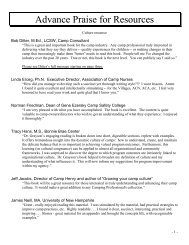Taking Camp Staff Training From Good To Best ... - Vision Realization
Taking Camp Staff Training From Good To Best ... - Vision Realization
Taking Camp Staff Training From Good To Best ... - Vision Realization
You also want an ePaper? Increase the reach of your titles
YUMPU automatically turns print PDFs into web optimized ePapers that Google loves.
<strong>Training</strong> A CIT <strong>To</strong> Lead A Hike<br />
The scaffolder’s task How that might look<br />
“You’re doing a good job of playing with the kids and keeping<br />
Defines the activity/task to be accomplished them entertained. But, have you noticed how spread out<br />
everyone is? Do you think that’s safe?”<br />
“So, everyone is all spread out over about 100 yards. How are<br />
Has the student think out loud to try and solve<br />
we going to get everyone together again? How are we going to<br />
the problem (focus is on recalling knowledge)<br />
make sure this doesn’t happen again?”<br />
“Boy, these kids sure don’t want to stay together! They’re a<br />
Supports the student through motivation,<br />
rough group though. Plus, it’s right after a candy canteen and<br />
praise, and understanding<br />
they’re wired!”<br />
“Okay, this is getting a little dangerous now. How about this. .<br />
.I’ll go up to the front and hold everyone up while you go to the<br />
Modifies the skill to be learned so it is within back and bring everyone to me. Once we’re all together, I’ll<br />
the student’s grasp<br />
start to talk about the expectations for a hike. You jump in<br />
anytime you want and then tell them our plan for how we’re<br />
going to stay together.”<br />
Making Behavioral <strong>Training</strong> The Standard<br />
Let’s recap. The menu of behavioral training methods includes role plays, modeling, and scaffolding. Role playing<br />
can be done during orientation and during the summer at in-service training events. Sometimes a mentor may choose to role<br />
play something one-on-one right before it actually happens. For example, the teacher may want to role play how the student<br />
is going to handle a behavior problem before they both go to the cabin and the student tries to deal with it appropriately.<br />
Modeling and scaffolding should be happening all the time all the way down the line. The director should model<br />
and scaffold skills with the assistant director, the assistant director with the unit heads, unit heads with group leaders, group<br />
leaders with counselors, and counselors with children. In general, the expert should be modeling and scaffolding for the<br />
lesser experts all the time. Certainly, sometimes the teaching happens out of the hierarchical order. For example, the director<br />
learns something from a counselor and the counselor from a child. However, leaving behavioral training to an edict (“Hear<br />
ye! Hear ye! Everyone begin modeling and scaffolding from this point forward!”) is not going to make a lot happen. Trying<br />
to make it part of the culture and modeling it everywhere possible with as many models (usually supervisors) as possible is<br />
one tactic. Beyond that approach, there must be structures in place to insure that people actually do it (see the culture<br />
resource). <strong>Camp</strong> is busy and there are a lot of competing demands and important things to be done.<br />
Make modeling and scaffolding part of people’s job description and have it be something on their agenda. For<br />
example, unit heads or group leaders (whoever supervises counselors) must spend two hours every day with their groups at<br />
the beginning, and one hour every two days when the counselors approach expert levels. These numbers are broad rules of<br />
thumb that will vary widely depending on the nature of the camp program. The point is to make sure that the experts spend<br />
time with their students on a regular basis.<br />
I’ve learned that just sending supervisors out into their groups doesn’t usually yield the best results. The task is too<br />
loosey goosey and random things happen – some good, some not so good. Thus, in the appendix you’ll find guidelines for<br />
supervisors spending time in their groups. With this structure, the supervisors know what they’re checking for. They already<br />
know about modeling and scaffolding and they’re looking for opportunities. Their supervisors are working with them a<br />
couple hours a week to help them do a good job of this. Meal meetings (see appendix) with the counselors, the group leader,<br />
and the group leader’s supervisor once or twice a week helps keep everyone on the same page and offers a point for<br />
accountability.<br />
Another useful way to make behavioral training the standard is to have a superior returning counselor in the cabin.<br />
For this to be worth while, the returning counselor must be a true expert at supervisor level quality – consult the “Seeing the<br />
forest for the trees” section for a discussion of expertise. In the very rare instances where a camp is fortunate enough to have<br />
a true expert in the cabin, modeling and scaffolding can happen on a continual basis, which is extremely powerful. Make<br />
sure the expert knows that it is their job to be a model and scaffolder and have the supervisor check in with that group to<br />
make sure it is happening as desired.<br />
A few other brief examples, which may or may not be applicable to your camp, are listed below.<br />
© Randall Grayson, Ph.D. www.visionrealization.com ver. 2.2 21





